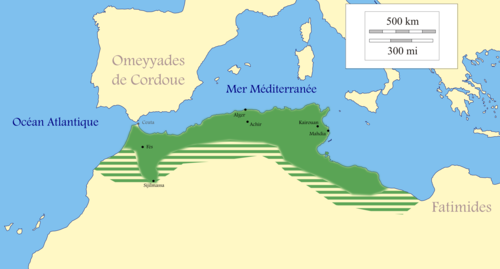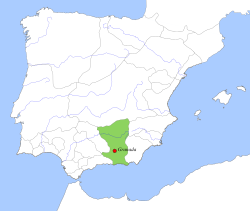Zirid dynasty
The Zirid dynasty were a Berber group. They were from what is now modern Algeria. The capital was Achir.
Zirid dynasty | |||||||||||||
|---|---|---|---|---|---|---|---|---|---|---|---|---|---|
| 972–1148 | |||||||||||||
 Zirid territory (green) at its maximum extent around the year 980 | |||||||||||||
| Status | Vassals of the Fatimid Caliphate (972–1048) Independent (1048–1148) | ||||||||||||
| Capital | Achir (before 1014), Kairouan (from 1014 to 1057), Mahdia (after 1057)[1] | ||||||||||||
| Common languages | Berber (primary), Maghrebi Arabic, African Latin, Hebrew | ||||||||||||
| Religion | Islam (Shia Islam, Sunni, Ibadi), Christianity (Roman Catholicism), Judaism | ||||||||||||
| Government | Monarchy (Emirate) | ||||||||||||
| Emir | |||||||||||||
• 973–984 | Buluggin ibn Ziri | ||||||||||||
• 1121–1148 | Abu'l-Hasan al-Hasan ibn Ali | ||||||||||||
| History | |||||||||||||
• | 972 | ||||||||||||
• | 1148 | ||||||||||||
| Currency | Dinar | ||||||||||||
| |||||||||||||
| Today part of | |||||||||||||
The Hammadids came from this group.
Zirid rulers
- Abul-Futuh Sayf ad-Dawla Bologhine Ibn Ziri (973-983)
- Abul-Fat'h al-Mansur ibn Buluggin (983-995)
- Abu Qatada Nasir ad-Dawla Badis ibn Mansur (995-1016)
- Sharaf ad-Dawla al-Muizz ibn Badis (1016–1062) declared independence from the Fatimids 1048, changed capital to Mahdia in 1057 after Kairouan was lost to the Banu Hilal.
- Abu Tahir Tamim ibn al-Muizz (1062–1108); changed the khutba to refer to the Abbasid Caliph in 1087, marking a final break with the Fatimids.
- Yahya ibn Tamim (1108–1131)
- Ali ibn Yahya (1115–1121)
- Abul-Hasan al-Hasan ibn Ali (1121–1152)
Zirid Dynasty Media
Surat Al-An'am of the "Nurse's Quran”, executed in fine Kufic script and commissioned by a nursemaid serving a Zirid sultan in 1020.
References
- ↑ Phillip C. Naylor (15 January 2015). North Africa, Revised Edition: A History from Antiquity to the Present. University of Texas Press. p. 84. ISBN 978-0-292-76190-2.





